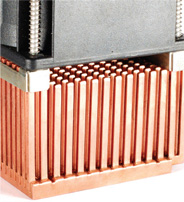CPUs Reach Their Potential Through Copper: The Hottest Computers Depend on Copper
 High-resolution version of this photo.
High-resolution version of this photo.A transistor is a device that amplifies an electrical signal or opens and closes a circuit. The very first microprocessors in 1971 had 2,300 transistors. The most recent generation of processors boasts about 1,720,000,000 transistors, nearly a 750,000 times increase! In a few years, some 10 billion are expected to reside on a single chip.
Each transistor generates heat during operation. The more transistors integrated on a chip, the more heat that's generated. Most processors are mounted onto circuit boards made from cellulose, a synthetic plastic with a relatively low melting temperature. In many cases, enough heat is generated from the processor to potentially melt and destroy the circuit board. This poses a unique problem - how to remove this excessive heat and keep the processor operating at peak efficiency? The answer lies in copper heat sinks.
Heat sinks are used to conduct heat away from an object. They feature a flat surface with various tube and/or fin protrusions to help increase heat dissipation. Most personal computers in the past have used a combination of fans and aluminum heat sinks with good success; however, aluminum is a less efficient thermal conductor and cannot meet these new and increasing heat demands like copper.
Copper's thermal conductivity, or capacity to conduct heat, is about 60 percent greater than that of aluminum, so copper can remove much more heat more quickly. The more heat removed from the processor, the more efficiently it will operate, with less potential for damage to other critical components. Copper heat sinks also help offset the need for computers to integrate cooling fans, significantly reducing noise, as well as energy consumption. In addition, copper is being used instead of aluminum in the electrical pathways of the millions of transistors on a chip. Not only do these new-generation chips run cooler, they perform faster. Cu
Resources:
Also in this Issue:
- Wind Power: A Positive Future
- Motor Rotors
- Flex Copper Circuits: Clean and Conductive
- From Copper to Bronze to Conquest
- CPUs Reach Their Potential Through Copper: The Hottest Computers Depend on Copper
